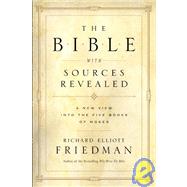
| Introduction | p. 1 |
| Collection of Evidence | p. 7 |
| Key to Sources | p. 32 |
| Genesis | p. 33 |
| Exodus | p. 119 |
| Leviticus | p. 191 |
| Numbers | p. 239 |
| Deuteronomy | p. 309 |
| Bibliography | p. 369 |
| Acknowledgments | p. 381 |
| Table of Contents provided by Blackwell. All Rights Reserved. |
The New copy of this book will include any supplemental materials advertised. Please check the title of the book to determine if it should include any access cards, study guides, lab manuals, CDs, etc.
The Used, Rental and eBook copies of this book are not guaranteed to include any supplemental materials. Typically, only the book itself is included. This is true even if the title states it includes any access cards, study guides, lab manuals, CDs, etc.
The process of identifying the biblical sources took centuries. The process of refining our identifications of these sources has been ongoing, and it continues to the present day. Initially, it was a tentative division based on simple factors: where the name of God appeared in the texts, similar stories appearing twice in the texts, contradictions of fact between one text and another. Accounts of this early identifying and refining may be found in many introductions to this subject and in my Who Wrote the Bible? The collection of evidence here is not a review of that history of the subject. It is a tabulation of the evidence that has emerged that establishes the hypothesis. It is grouped here in seven categories, which form the seven main arguments for the hypothesis in my judgment.
1. Linguistic
When we separate the texts that have been identified with the various sources, we find that they reflect the Hebrew language of several distinct periods.
The development of Hebrew that we observe through these successive periods indicates that:
This chronology of the language of the sources is confirmed by Hebrew texts outside the Bible. The characteristics of Classical Biblical Hebrew are confirmed through comparison with inscriptions that have been discovered through archaeology, which come from the period before the Babylonian exile (587 BCE). The characteristics of Late Biblical Hebrew are confirmed through comparison with the Hebrew of later sources such as the Dead Sea Scrolls.
Despite the power of this evidence, it is practically never mentioned by those who oppose the hypothesis.
2. Terminology
Certain words and phrases occur disproportionately -- or even entirely -- in one source but not in others. The quantity of such terms that consistently belong to a particular source is considerable. Thus:
The mountain that is called Sinai in J and P (twenty times) is called Horeb or "the Mountain of God" in E and D (fourteen times). In thirty-four occurrences of these names, there is no exception to this distinction.
The phrase "in that very day" (beesem hayyôm hazzeh) occurs eleven times in the Torah. Ten of the eleven are in P. (And the eleventh is in R, in a passage that R modeled on P; Deut 32:48.)
The phrase "the place where YHWH sets his name" or "the place where YHWH tents his name â€occurs ten times in D but never in J,E,or P.
The Bible with Sources Revealed
Excerpted from The Bible with Sources Revealed by Richard E. Friedman
All rights reserved by the original copyright owners. Excerpts are provided for display purposes only and may not be reproduced, reprinted or distributed without the written permission of the publisher.